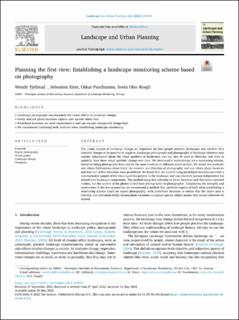| dc.contributor.author | Fjellstad, Wendy Jane | |
| dc.contributor.author | Eiter, Sebastian | |
| dc.contributor.author | Puschmann, Oskar | |
| dc.contributor.author | Krøgli, Svein Olav | |
| dc.date.accessioned | 2022-10-11T07:19:45Z | |
| dc.date.available | 2022-10-11T07:19:45Z | |
| dc.date.created | 2022-06-20T10:34:34Z | |
| dc.date.issued | 2022-05-20 | |
| dc.identifier.citation | Landscape and Urban Planning. 2022, 226 . | en_US |
| dc.identifier.issn | 0169-2046 | |
| dc.identifier.uri | https://hdl.handle.net/11250/3025246 | |
| dc.description.abstract | The visual impacts of landscape change are important for how people perceive landscapes and whether they consider changes to be positive or negative. Landscape photographs and photographs of landscape elements may capture information about the visual qualities of landscapes and can also be used to illustrate, and even to quantify, how these visual qualities change over time. We developed a methodology for a monitoring scheme, based on taking photographs from exactly the same locations at different points in time. We tested two methods: one where fieldworkers chose freely the location and direction of photographs, and one where photo locations and four out of five directions were predefined. We found that the method using predefined locations provided a representative sample of the visual qualities present in the landscape and was relatively person-independent but missed rare landscape components. The method using free selection of photo locations and directions captured rarities, but the content of the photos varied from photographer to photographer. Considering the strengths and weaknesses of the two approaches, we recommend a method that combines aspects of both when establishing a monitoring scheme based on repeat photography, with predefined locations to ensure that the entire area is covered, and additional freely chosen photo locations to capture special subject matter that would otherwise be missed. | en_US |
| dc.language.iso | eng | en_US |
| dc.publisher | Elsevier B.V. | en_US |
| dc.rights | Attribution-NonCommercial-NoDerivatives 4.0 Internasjonal | * |
| dc.rights.uri | http://creativecommons.org/licenses/by-nc-nd/4.0/deed.no | * |
| dc.title | Planning the first view: Establishing a landscape monitoring scheme based on photography | en_US |
| dc.title.alternative | Planning the first view: Establishing a landscape monitoring scheme based on photography | en_US |
| dc.type | Peer reviewed | en_US |
| dc.type | Journal article | en_US |
| dc.description.version | publishedVersion | en_US |
| dc.rights.holder | © 2022 The Authors. | en_US |
| dc.source.pagenumber | 13 | en_US |
| dc.source.volume | 226 | en_US |
| dc.source.journal | Landscape and Urban Planning | en_US |
| dc.identifier.doi | 10.1016/j.landurbplan.2022.104470 | |
| dc.identifier.cristin | 2033286 | |
| dc.relation.project | Norges forskningsråd: 194051 | en_US |
| dc.source.articlenumber | 104470 | en_US |
| cristin.ispublished | true | |
| cristin.fulltext | original | |
| cristin.qualitycode | 2 | |

